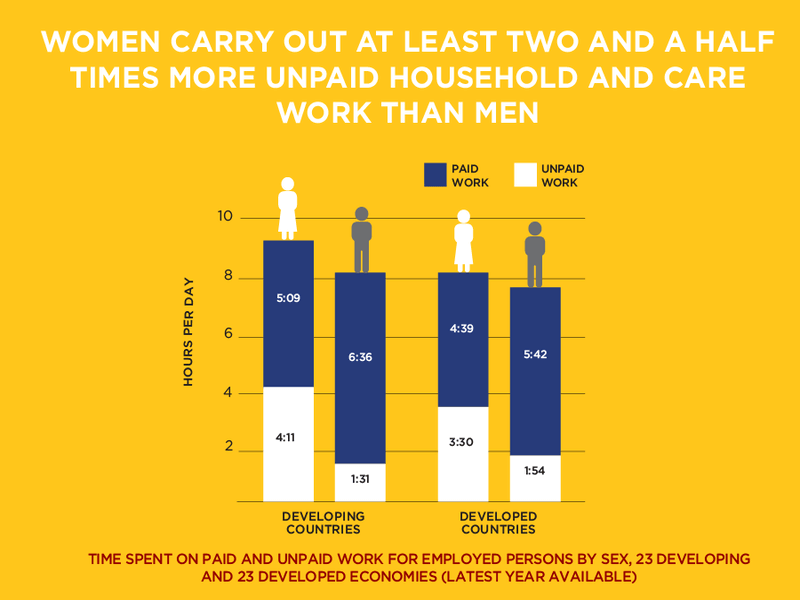
Unpaid work, such as household labour, caregiving, and volunteer work, has substantial economic value but is often overlooked in formal economic calculations. In India, where women primarily do unpaid work, the economic value is significant yet under-recognized in GDP statistics. Read here to learn more.
Unpaid care work prevents 708 million women from participating in the labour market
Care responsibilities are excluding and holding back millions of women worldwide from taking paid employment, and with climate and demographic changes on course to increase the demand for care, measures to support the care economy are urgently needed, according to a new International Labour Organisation (ILO) brief.
Unpaid work
An estimated 708 million women worldwide are outside the labour force because of unpaid care responsibilities, according to new ILO global estimates.
In 2023, 748 million people (aged 15 or older) were not participating in the global labour force because of care responsibilities, accounting for a third of all working-age persons outside of the labour force. Of these, 708 million were women and 40 million were men.
- The new estimates, presented in the ILO Statistical Brief The impact of care responsibilities on women’s labour force participation, are derived from data from 125 countries.
- They indicate that care responsibilities present the main barrier to women entering and staying in the labour force, while men are more likely to cite other personal reasons for being outside the labour force, such as education and health issues.
- This stark gender discrepancy highlights the disproportionate role that women take on in child-rearing, care, and support for persons with disabilities and those in need of long-term care, housekeeping, and other care responsibilities.
- Globally, around 1.6 billion women and 800 million men are outside the labour force, with 45 per cent of these women and 5 per cent of these men citing care responsibilities as the reason for their non-participation.
- Among women aged 25 to 54, the proportion citing care as the reason for being outside the workforce rises to two-thirds (379 million women). Women with lower education and those in rural areas also face higher barriers to workforce participation due to care responsibilities.
- Regionally, the highest percentage of women outside the labour force citing care responsibilities as the reason is in Northern Africa (63 per cent of women outside the labour force), followed by the Arab States (59 per cent).
- In Asia and the Pacific, the figure is 52 per cent with little variation in the subregions.
- In the Americas, the variation is stark, with 47 per cent citing care as the main reason for being outside the labour force in Latin America and the Caribbean, compared to just 19 per cent in Northern America.
- In Europe and Central Asia, 21 per cent of women report caregiving as the main barrier, with Eastern Europe having the lowest rate globally (11 per cent).
Economic Contributions of Unpaid Work in India
While the System of National Accounts (SNA) guidelines have included some forms of household production in GDP since 1993, unpaid care work childcare, elder care, cooking, and cleaning remain excluded.
These tasks fall under what is often referred to as the “care economy,” which is largely sustained by women worldwide.
Recognizing this labour as a valuable economic contribution is essential, as it underpins both the paid workforce and societal functioning.
- The scale of Unpaid Work:
- According to the Time Use Survey (TUS) 2019 by the Ministry of Statistics and Programme Implementation (MoSPI), over 80% of Indian women and around 25% of men engage in unpaid domestic and caregiving activities daily. This translates to billions of hours of labour each year that are not monetized.
- The International Labour Organization (ILO) estimates that unpaid work constitutes about 10% of global GDP, with India’s contribution likely similar or even higher due to its large population and gendered labour division.
- Monetary Valuation Estimates:
- Research by Oxfam India in 2020 estimated the economic value of unpaid work performed by women in India at around ₹19 lakh crore ($271 billion), equivalent to nearly 8% of the country’s GDP at the time. Other studies suggest the value could reach 20%–39% of India’s GDP if unpaid work were included in economic measures.
- Impact on Women’s Economic Participation:
- Unpaid work limits women’s participation in the formal economy, affecting economic growth and individual incomes. For example, it’s estimated that if unpaid work were compensated, it would add millions of women to India’s workforce, increasing their economic agency and potentially reducing gender-based economic disparities.
- A study by McKinsey Global Institute suggests that closing the gender gap in labour force participation, partially by addressing unpaid work burdens, could add $770 billion to India’s GDP by 2025.
Implications and Policy Considerations

Valuing unpaid care work in economic terms could potentially lead to policies that offer social protections, such as parental leave, pensions for caregivers, or caregiving subsidies.
Countries like Canada and Australia have integrated unpaid labour in satellite accounts, presenting an alternate model for countries seeking to understand and address the economic importance of care work.
Expanding these policies could address gender inequality by reducing the disproportionate burden of unpaid labour on women and fostering a more inclusive economic framework.
- Policy Initiatives:
- Including unpaid work in GDP could reshape policies on labour rights, social security, and economic inclusivity. Governments in several countries are exploring ways to acknowledge unpaid work, including time-use surveys and providing support for unpaid caregivers.
- In India, providing greater social support for unpaid caregivers through policies like paid leave, subsidized child care, or incentives for men to share domestic duties could encourage broader participation in paid labour.
- Economic and Social Impacts:
- Recognizing the economic value of unpaid work could also empower women economically and socially by highlighting their contributions beyond traditional income metrics. Such recognition could shift societal perceptions about gender roles and labour distribution.
Conclusion
Acknowledging and addressing the economic value of unpaid work in India is crucial to advancing gender equity and enhancing economic development.
Addressing the invisibility of unpaid care work is fundamental to achieving gender equality, fair economic representation, and improved social policies. Instituting frequent Time Use Surveys and embedding unpaid care work in GDP calculations could lead to substantial shifts in how economies support care labour and address gender-based disparities.
ILO data show that since 2018 many countries have made progress in promoting the participation of women carers by increasing investments in early childhood care and education.
However, in a world being reshaped by demographic shifts, with ageing populations, and climate change, which intensifies unpaid care work, the demand for care services is likely to increase.
The recent ILO Resolution underlines the importance of adequate investment in care policies. It will be essential if we are to tackle growing inequality and move towards greater social justice.
Frequently Asked Questions (FAQs)
Q. What is the concept of unpaid work?
Ans: Unpaid work refers to the labour or services provided by individuals without receiving monetary compensation. It is often overlooked in health economic evaluations and guidelines, despite its significance in various domains.
Q. What are examples of unpaid work?
Ans: “Unpaid work” includes activities like routine household work (e.g. cooking, cleaning and gardening), caring for children and other family and non-family members, volunteering, and shopping.
Related articles:
- Care Economy
- Women in the workforce: Growth and challenges
- Women’s Urban Employment Guarantee Act (WUEGA)
- National Policy for Women
-Article by Swathi Satish






Leave a Reply